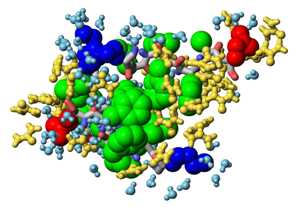
Dmitri Klimov
Professor
School of Systems Biology
George Mason University
10900 University Boulevard, MS 5B3
Manassas, Virginia 20110
Phone: 703-993-8395 | Email: dklimov@gmu.edu | Web: www.binf.gmu.edu
 Computer simulations of biomolecules have become an important research tool,
which complements both experimental and analytical studies. Computer simulations are essentially
numerical experiments, which share much in common with "traditional" experiments, but also
offer several important advantages. First, in contrast to "traditional" experiments, a researcher
can readily probe and examine every microscopic detail of the molecular system, down to the level
of individual atoms. This provides an unparallel opportunity for in-depth investigation of
biomolecules. Second, computer simulations are always built on the basis of some theoretical model,
which strives to describe the properties of a molecular system. Therefore, computer simulations
serve as a powerful validation tool for theories. If a theory successfully captures the
reality of biomolecular system, then computer simulations should reproduce
experimental observations.
Computer simulations can be considered as interdisciplinary art,
which requires good knowledge of physical chemistry, programming, computer science, and biology.
Computer simulations of biomolecules have become an important research tool,
which complements both experimental and analytical studies. Computer simulations are essentially
numerical experiments, which share much in common with "traditional" experiments, but also
offer several important advantages. First, in contrast to "traditional" experiments, a researcher
can readily probe and examine every microscopic detail of the molecular system, down to the level
of individual atoms. This provides an unparallel opportunity for in-depth investigation of
biomolecules. Second, computer simulations are always built on the basis of some theoretical model,
which strives to describe the properties of a molecular system. Therefore, computer simulations
serve as a powerful validation tool for theories. If a theory successfully captures the
reality of biomolecular system, then computer simulations should reproduce
experimental observations.
Computer simulations can be considered as interdisciplinary art,
which requires good knowledge of physical chemistry, programming, computer science, and biology.
In our laboratory we are working on two aspects of biomolecular simulations.
First, we are applying various simulation methods to understand the kinetics of formation of
amyloid fibril structures at molecular level. Second, we are interested in structural
transitions in proteins, which are caused by the application of external mechanical force.
Both directions are of immense biophysical and biomedical importance, because they may help to
find therapeutic approaches against Alzheimers and other amyloid related diseases or to
describe several important cellular processes, such as cell adhesion or cytoskeleton elasticity.
To learn more about our research please follow the link
Research Interests.
The description of my graduate courses, which are all related to computational biophysics and
simulations, is available on the left panel. Starting with Spring 2006 these
courses will be organized in a three semester sequel. The first course is "Introduction to
biophysics" followed by "Introduction to computer simulations of biomolecules".
The final course in this series is "Research topics in biomolecular simulations",
which capitalizes on the first two courses and is based on individual student research projects.
If you are a student interested in pursuing the research in biomolecular simulations, feel free
to contacts us.